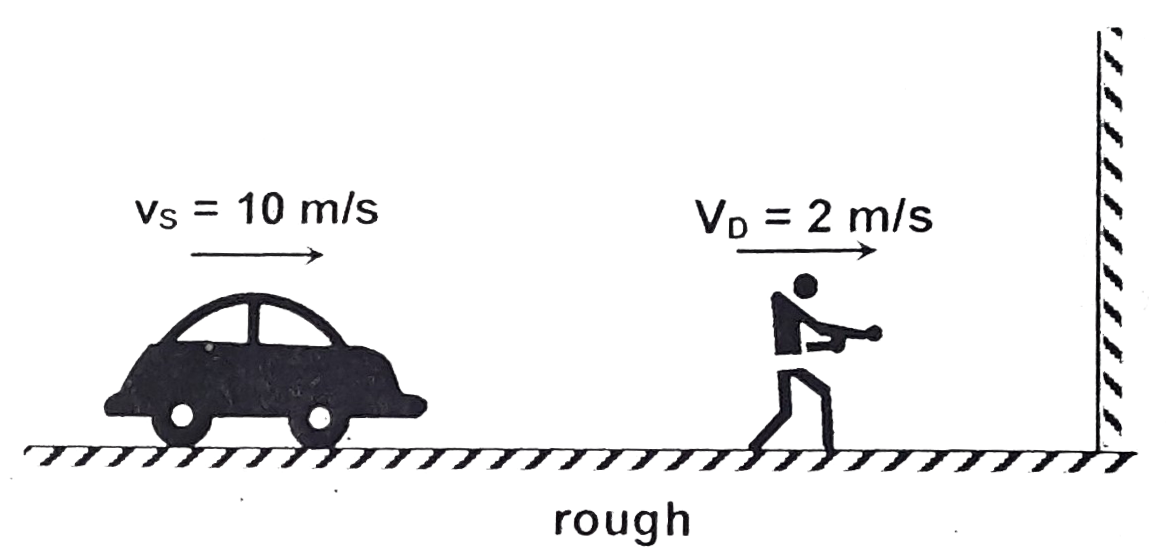A car is moving towards a high cliff. The car driver sounds a horn of frequency f. The reflected sound heard by the driver has a frequency 2f. if v be the velocity of sound, then the velocity of the car, in the same velocity units, will be
v√2
v3
v4
v2
The correct Answer is:d
To solve the problem, we need to apply the concept of the Doppler effect, which describes how the frequency of a wave changes for an observer moving relative to the source of the wave.
1. Identify the Given Information:
- Frequency of the horn sounded by the car, f.
- Frequency of the reflected sound heard by the driver, 2f.
- Velocity of sound in air, v.
2. Understand the Scenario:
- The car is moving towards a cliff, which acts as a reflector of sound.
- The car is the source of the sound, and the cliff is the observer initially.
3. Apply the Doppler Effect for the Source:
- When the car (source) sounds the horn, the frequency heard by the cliff (observer) can be calculated using the Doppler effect formula:
f′=vv−vdf
where vd is the velocity of the car.
4. Calculate the Frequency Heard by the Cliff:
- The frequency f′ heard by the cliff is f′=2f.
- Therefore, we can write:
2f=vv−vdf
- Dividing both sides by f gives:
2=vv−vd
5. Rearranging the Equation:
- Cross-multiplying gives:
2(v−vd)=v
- Expanding this gives:
2v−2vd=v
- Rearranging leads to:
2v−v=2vd⟹v=2vd
6. Finding the Velocity of the Car:
- From the equation v=2vd, we can express the velocity of the car:
vd=v2
7. Conclusion:
- The velocity of the car vd is v2.
Final Answer:
The velocity of the car is v2.
- Frequency of the horn sounded by the car, f.
- Frequency of the reflected sound heard by the driver, 2f.
- Velocity of sound in air, v.
- The car is moving towards a cliff, which acts as a reflector of sound.
- The car is the source of the sound, and the cliff is the observer initially.
- When the car (source) sounds the horn, the frequency heard by the cliff (observer) can be calculated using the Doppler effect formula:
f′=vv−vdf
where vd is the velocity of the car.
- The frequency f′ heard by the cliff is f′=2f.
- Therefore, we can write:
2f=vv−vdf
- Dividing both sides by f gives:
2=vv−vd
- Cross-multiplying gives:
2(v−vd)=v
- Expanding this gives:
2v−2vd=v
- Rearranging leads to:
2v−v=2vd⟹v=2vd
- From the equation v=2vd, we can express the velocity of the car:
vd=v2
- The velocity of the car vd is v2.
The velocity of the car is v2.
Similar Questions
A car travels at a speed of 'a' towards a high wall. The driver sounds a horn of frequency 'n'. If V is the velocity of sound in air, frequency of reflected sound heard by the driver is
View SolutionA car is moving towards a fixed wall, it blows form of frequency of 440Hz . The frequency of reflected sound observed by the driver is 480Hz then find the speed of car in km/hr. (Speed of sound is 350msec
View SolutionA car is moving with 90kmh−1 blows a horn of 150 Hz, towards a cliff. The frequency of the reflected sound heard by the driver will be (speed of sound in air is 340ms−1 )
View SolutionA source of sound is travelling towards a stationary observer. The frequency of sound heard by the observer is 25% more that the actual frequency. If the speed of sound is v, that of the source is
View Solutiona bus is moving towards and stationary observer with speed 20 m/s blows a horn of frequency 200 Hz. the frequency of sound heard by the observer is approximately ( take speed of sound 320 m/s)
View SolutionA Car is travelling at v10ms−1 and sounds horn of frequency 990 Hz. The apparent frequency heard by a police chasing the car at v9ms−1, where V is velocity of sound
View SolutionA car travelling with speed V50 towards a hill, (where v is speed of sound in air), sounds a horn of frequency 196 Hz. The number of beats heard per second by the driver when reflected sound reaches the driver is
View SolutionA person feels 2.5% difference of frequency of a motor-car horn. If the motor-car is moving towards the person and the velocity of sound is 320 m/s, then the velocity of motor car will be (approximately)
View SolutionA car is moving with a constant velocity 10m/s towards the stationary wall. The car blows a horn of frequency 320Hz. The velocity of sound in air is 330m/s. The beats frequency received by the observer is

View Solutiona bus is moving with a velocity 4 m/s towards a wall, the driver sounds a horn of frequency 173 Hz . if the speed of sound in air is 350 m/s. the number of beat heard per second by a passanger on the bus will be
View Solution
